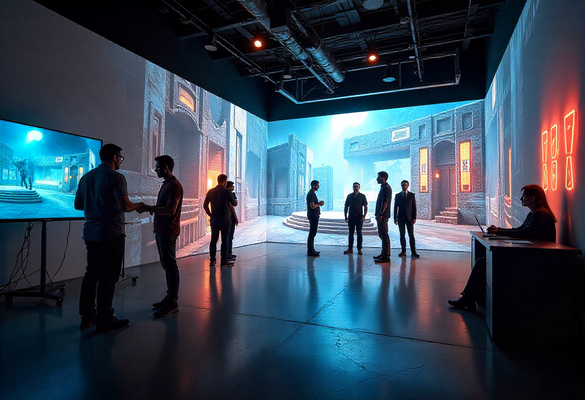Virtual Set Design with CAVE Technology: Transforming Pre-Production Workflows

The film industry stands at a revolutionary crossroads where virtual set design meets cutting-edge CAVE technology, fundamentally changing how filmmakers approach pre-production planning. Gone are the traditional limitations of physical set construction, budget constraints, and location dependencies that have long challenged creative teams. CAVE pre-production environments now enable directors, production designers, and cinematographers to build, modify, and perfect entire worlds before stepping foot on a physical set.
Virtual set design through CAVE systems represents more than technological advancement – it's a complete paradigm shift in filmmaking methodology. Production teams can now iterate through countless design variations, test lighting scenarios, and perfect camera movements within immersive digital environments that feel as tangible as physical sets. This transformation of the virtual production workflow eliminates the costly trial-and-error processes that traditionally plague film production, replacing them with precise, data-driven creative decisions.

Understanding Virtual Set Design in the CAVE Environment
Virtual set design within CAVE technology creates three-dimensional, interactive environments where every element can be manipulated, tested, and refined in real-time. Unlike traditional concept art or 2D storyboards, these digital set designs allow entire production teams to walk through and interact with proposed sets before construction begins.
The CAVE pre-production process begins with importing 3D models, architectural plans, or concept designs into the immersive environment. Production designers can then scale environments to actual size, allowing directors and cinematographers to experience the spatial relationships between characters, props, and set pieces exactly as they will appear during filming. This level of precision eliminates the guesswork that often leads to expensive modifications during principal photography.
Digital set design within CAVE systems enables unprecedented creative flexibility. Set walls can be moved instantly, ceiling heights adjusted with simple gestures, and entire room layouts reconfigured in seconds. Lighting designers can experiment with different scenarios, from natural daylight variations to complex artificial lighting setups, seeing immediate results without the time and expense of physical lighting equipment.
The collaborative nature of CAVE environments transforms traditional pre-production meetings. Instead of discussing abstract concepts around conference tables, creative teams stand within their proposed sets, pointing to specific areas, walking through actor movements, and making real-time adjustments that everyone can immediately visualize and evaluate.
Revolutionizing Film Pre-Visualization Through Immersive Technology
Film pre-visualization reaches new heights of sophistication through CAVE technology implementation. Traditional previz techniques, while valuable, often fail to convey the true spatial relationships and emotional impact of designed environments. CAVE systems bridge this gap by providing cinema-quality visualization that matches the final production's visual fidelity.
The virtual filmmaking process within CAVE environments allows directors to block entire scenes with precision that was previously impossible during pre-production. Camera movements can be planned and executed within the virtual space, with cinematographers able to test different lens choices, camera angles, and movement patterns while standing in the actual positions they will occupy during filming.
Action sequences benefit enormously from CAVE pre-visualization capabilities. Stunt coordinators can plan complex choreography within virtual environments, identifying potential safety issues and optimization opportunities before performers set foot on set. Explosion sequences, car chases, and elaborate fight scenes can be rehearsed and refined multiple times without the costs and risks associated with physical rehearsals.
The emotional impact of set designs becomes immediately apparent within CAVE environments. Directors can gauge how different set configurations affect the mood and atmosphere of scenes, making creative decisions based on visceral responses rather than theoretical discussions. This immediate feedback loop accelerates the creative process while ensuring that final set designs achieve their intended emotional effects.

Streamlining Virtual Production Workflows for Maximum Efficiency
The virtual production workflow benefits tremendously from CAVE technology integration, creating streamlined processes that reduce both time and costs while improving creative outcomes. Traditional pre-production workflows often involve multiple iterations of drawings, models, and prototypes that require significant time investment before teams can evaluate their effectiveness.
CAVE systems compress these traditional timelines by enabling immediate visualization and modification of design concepts. Production designers can present multiple set design options within a single CAVE session, allowing creative teams to compare alternatives side-by-side and make informed decisions quickly. This acceleration of the decision-making process eliminates weeks of traditional back-and-forth communication and revision cycles.
The integration of CAVE pre-production with post-production planning creates seamless workflows that extend far beyond set design. Visual effects supervisors can plan complex VFX sequences within virtual sets, identifying integration points between practical and digital elements before filming begins. This forward-thinking approach prevents costly post-production surprises and ensures that practical sets are designed with VFX requirements in mind.
Budget optimization becomes more precise through CAVE-based virtual production workflows. Production teams can evaluate the cost-effectiveness of different set design approaches by experiencing them firsthand before making construction commitments. This capability prevents expensive set modifications during principal photography and ensures that budget allocations align with creative priorities.
Technical Implementation: Building Digital Sets in CAVE Systems
The technical process of creating digital set designs for CAVE environments requires specialized workflows that bridge traditional design tools with immersive visualization technology. Production designers typically begin with standard 3D modeling software, creating detailed set designs that can be imported into CAVE systems for immersive evaluation.
CAVE-compatible digital set design requires attention to scale, lighting, and texture details that may not be critical in traditional 3D modeling. Every surface texture, material property, and lighting interaction must be optimized for real-time rendering within the CAVE environment while maintaining visual quality that matches production standards.
The virtual filmmaking process within CAVE systems demands integration with existing production tools and pipelines. Set designs created in CAVE environments must be exportable to traditional construction drawings, VFX reference materials, and on-set visualization tools. This interoperability ensures that CAVE-based pre-production work translates seamlessly into practical production requirements.
Lighting design within CAVE virtual sets requires sophisticated rendering capabilities that can simulate various lighting conditions in real-time. Production teams can test different times of day, weather conditions, and artificial lighting scenarios while standing within the virtual environment, making lighting decisions based on immediate visual and emotional impact rather than theoretical calculations.
Real-World Applications: From Concept to Screen
Major film productions now regularly integrate CAVE technology into their virtual set design processes, achieving remarkable results in both creative quality and production efficiency. Period films benefit particularly from CAVE pre-production capabilities, allowing production designers to create historically accurate environments and test their visual impact before committing to expensive period-accurate construction.
Science fiction and fantasy productions leverage CAVE systems to create otherworldly environments that would be impossible to construct practically. Directors can walk through alien landscapes, futuristic cities, and magical realms, making creative decisions about these fantastical environments based on direct sensory experience rather than abstract visualization.
The virtual production workflow proves especially valuable for films requiring multiple location shoots. Production teams can scout and design virtual versions of international locations, allowing creative teams to plan complex sequences without the expense and logistical challenges of international location scouting. This capability proves particularly valuable for action films requiring exotic locations that may be inaccessible or dangerous for traditional filming.
Independent filmmakers and smaller production companies gain access to production capabilities previously available only to major studios. CAVE technology democratizes high-end pre-production tools, allowing creative teams with limited budgets to achieve professional-quality virtual set design and pre-visualization that significantly improves their final productions.

The Future Impact on Film Production
Virtual set design through CAVE technology represents just the beginning of a fundamental transformation in film production methodologies. As the technology continues evolving, the integration between virtual and physical production will become even more seamless, creating hybrid workflows that optimize both creative flexibility and production efficiency.
The film pre-visualization capabilities of current CAVE systems will expand to include real-time collaboration between remote teams, allowing international production collaborations that were previously logistically impossible. Directors in one location will be able to walk through virtual sets with production designers in different countries, making real-time creative decisions that immediate affect digital set designs.
Machine learning integration with CAVE systems will eventually enable automated optimization of set designs based on narrative requirements, genre conventions, and audience psychology research. These intelligent systems will suggest design modifications that enhance storytelling effectiveness while maintaining production feasibility and budget constraints.
The virtual filmmaking process will continue evolving toward complete integration of pre-production, production, and post-production workflows. CAVE-designed virtual sets will seamlessly transition into production-ready environments that combine practical and digital elements in ways that are invisible to audiences but revolutionary for filmmakers.




